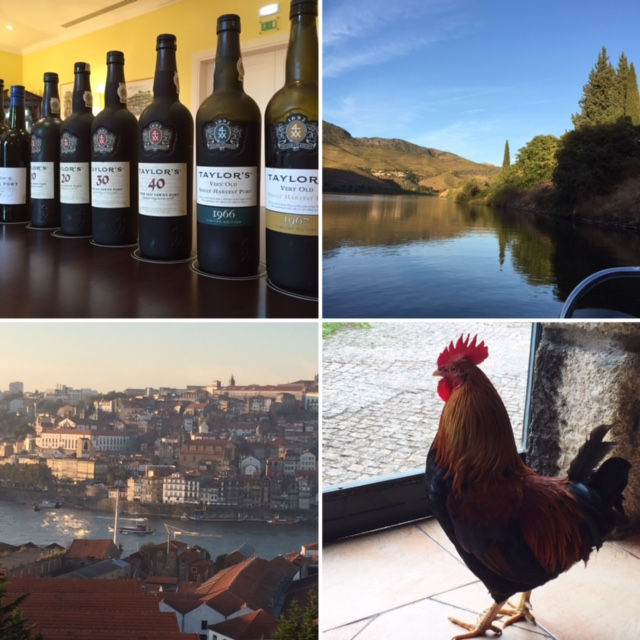Is co-fermentation the new black for Port?
- Joanna Simon

- Oct 29, 2016
- 4 min read

Co-fermenting – fermenting different grape varieties together happened by default in the past
It was a while since I’d been in the Douro when I went last month. The last time I was on a port mission it was to research the ageing and blending of Tawny ports, so I spent some time investigating casks of slumbering Tawny in the lodges in Oporto and spent even more time ensconced in a plain white tasting room with three blenders and hundreds of samples of Tawny port.



On the recent visit I went up the Douro to vineyards and estates (quintas) and was astonished at the developments. I wouldn’t go to other wine growing regions expecting nothing much to have changed, so why think that about the Douro? I suppose it’s because port and port drinking are so steeped in history and rooted in tradition.
What fascinated me were developments in the vineyards and fermentation vats, at least in the Fladgate group of Taylors, Fonseca, Croft and their associated quintas, the best known of which are (left from top to bottom) Quinta de Vargellas for Taylors, Quinta do Panascal for Fonseca and Quinta da Roeda for Croft. As so often in the recent history of wine (think of organic growing or the rehabilitation of cement tanks and amphorae), some of the key developments have been a case of rediscovery more than innovation.
To understand what David Guimaraens, head winemaker and technical director, has been doing in the vineyards and vat rooms you need to know a bit of the history and to remember that the Douro vineyards are on very steep slopes. Let’s go.
Planting has taken place in three broad phases: replanting in the first decades of the 20th century after phylloxera wiped out most of the Douro’s and the world’s vineyards; the 1970s, when the Oporto-based shippers bought estates and began to get involved in growing and vinification; and the recent and current phase.
The first-phase vineyards were planted on narrow terraces (often only one or two rows wide) supported by dry-stone walls, and the grape varieties were all mixed up – known as field-blends.
The second phase was designed for mechanisation, so patamares (‘platforms’, below right) were created – wide, banked-up earth terraces without stone walls – and the vines were planted by variety, block by block, so they could be picked and vinified separately. The number of varieties decreased, because those with grapes rich in colour and tannin were being singled out. It also emerged before long that patamares brought erosion and a greater dependence on herbicides.

"We made fruitier, easier ports that were accessible earlier, but we lost some of the complexity and we lost diversity."

The third phase has involved vertical planting (right, below): up and down rows that allow mechanisation, more vines per hectare and more even exposure to the sun. The downside is that it’s only possible up to a slope of 35 percent, which isn’t much in the Douro, so there are still terraces and probably always will be. Crucially, this third phase has also involved reintroducing some of the abandoned grape varieties, identifying where each will do best and planting them in blocks.
David Guimaraens (below) explains: “When we started picking and fermenting separately [in the 1970s] we made port more consistent. We pulled the bottom up, but I believe we pulled the top down. We made fruitier, easier ports that were accessible earlier, but we lost some of the complexity and we lost diversity because we were using fewer varieties. We made ports that were very good but that weren’t so differentiated from one another.” The younger vines of the new vineyards also contributed to fruitier, more obvious, but less complex ports.
Patamares (above right) and vertical planting (right)

Reintroducing grape varieties is a key to his aim of achieving greater complexity, but so too is what happens when the grapes are picked. The top ports, including all vintage ports, are still foot-trodden in traditional lagares (the large, shallow, stone troughs), so no change there, but they’re now co-fermented, meaning different grape varieties are fermented together, rather than being blended later. The blend is decided in the vineyard. There are three reasons: physical, chemical and sensory.
I don’t want to get too technical, but to give an example for each reason in order: co-fermenting the thick-skinned Touriga Franca with Tinta Barroca or Tinta Roriz can help with the extraction of juice from the Touriga; co-fermenting Tinta Barroca with Roriz can help fix the colour of the Barroca; co-fermenting Touriga Franca with a little of the higher acid Tinta Cão can enhance Touriga Franca’s natural depth of flavour.
So why not plant field blends again? “With field blends you need all varieties to do well to have a great vintage. In the past, they understood empirically that balance was achieved by blending the grape varieties,” David says. The difference now is that he plans the blends in the vineyards but does the blend itself in the fermentation vats. .In the past the vineyard was the blend. Wheel almost full circle. I must visit the Douro again soon. Very soon.

A few more photos to give a flavour of the Douro and Oporto.
Right: Alastair Robertson, chairman of the Fladgate Partnership, with his wife Gilly at their beloved Quinta da Vargellas, and other views from the property.
Below, clockwise from top left: Taylor's Aged Tawnies and Single Harvest Tawnies – the 1967 is particularly good; boating on the river Douro near Vargellas; Taylor's' appropriately majestic cockerel ruling the roost at the new visitor's centre in Oporto; view from my room at The Yeatman, the splendid Fladgate-owned hotel in Oporto.

All photographs by Joanna Simon





Comments